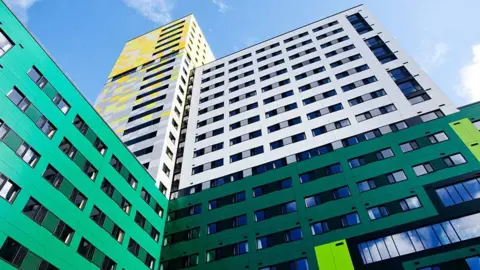How flammable cladding gets approved
 EPA
EPANewsnight has obtained confidential reports that help explain how flammable material has become more common on tall buildings.
Combustible cladding has been permitted based on reports arguing fires involving combustible aluminium panels would behave similarly to ones with non-combustible ceramic tiles.
Developers use them to persuade inspectors to sign off buildings.
Exova, the company that produced the reports, refused to comment.
The company, also known as Exova Warringtonfire, is a fire testing and engineering company.
It has previously cited client confidentiality in refusing to comment and has not responded to requests since Newsnight obtained copies of the reports relating to two buildings late on Friday afternoon.
The confidential reports obtained by Newsnight contain assessments that persuaded inspectors that a given cladding design was safe and met legal standards.
Part of the engineers' reasoning was that, in a fire test, you would get similar results if you were to use either combustible aluminium panels or non-combustible ceramic tiles.
As a consequence, it argued, you could use successful fire tests involving ceramic tiles as a guide to the likely fire safety of a system using aluminium panels.
The report said: "If this... would be tested... the external flame spread results would be comparable to those with ceramic tile."
While there is no test that contradicts the authors' conclusions about the safety of the proposed cladding system, experts were surprised at the arguments advanced by the authors, which they felt was not strongly supported by evidence.
Aluminium composite panels are two sheets of thin aluminium around a "core" of some other substance. In a fire, these panels can "delaminate": the outer aluminium peels away, exposing the inner core.
If the inner core is combustible, these panels can allow the rapid spread of fire. Ceramic tiles do not contain combustible material and do not have layers that can come apart.
That fire performance is why so much attention has been paid to the use of aluminium panelling with a plastic core on Grenfell Tower. The government is currently demanding local authorities and housing associations send in samples of aluminium panelling for test.
One of the documents obtained by Newsnight was used to approve materials now in use in the Greetham Street student residences run by Unite Students, a student accommodation provider, in Portsmouth.
 Getty Images
Getty ImagesThe two reports both related to a style of cladding system similar to that used at Grenfell Tower: a combustible insulation material underneath aluminium composite panels.
Neither of the reports, though, proposed using the same materials as those used on Grenfell Tower. Both reports related to aluminium cladding containing fire retardants.
While the reports related to slightly different designs and had different authors, both advanced the same technical arguments which concerned experts.
These assessments, one said, "appeared to extrapolate an apple into an orange" and they agreed that this showed up weaknesses in the way that we make sure buildings are fire safe.
These reports - known as "desktop studies" - are a legal alternative to laboratory testing.
There are several regulatory routes to demonstrating to an inspector that cladding is safe on a tall building.
First, all the parts of the cladding can be tested separately and found to be of "limited combustibility", broadly meaning that the parts will not catch alight or spread fire.
If, however, some parts do not meet that standard, developers can arrange for a laboratory to construct a model of the entire proposed wall system and assess what would happen in a fire.
But if a developer wishes to follow plans similar to a setup which has already been fire-tested, they can ask an engineer to perform a desktop study, certifying that the proposed construction would pass the test without the need for one to be carried out.
 Unite Students
Unite StudentsThe scale of the use of desktop studies is actually still unknown: they are not published and are even considered commercially confidential.
But there is now growing concern in government that desktop studies may be an important factor - directly and indirectly - in explaining why so many buildings have been found to have combustible components within their cladding.
Newsnight has applied for documents from the Royal Borough of Kensington and Chelsea to establish whether desktop studies were used to justify the cladding configuration used on the Grenfell Tower.
Unite, which runs the building in Portsmouth, said: "Fire safety is always a key priority for Unite - which is why we work with the Avon Fire and Rescue Service to ensure that our buildings, policies and procedures not only comply with existing regulations but exceed them.
"As a matter of general practice, we regularly review and assess the fire risk in all of our buildings, using members of the Institution of Fire Engineers."
Both documents were commissioned and paid for by Kingspan, the makers of the insulation used in the cladding.
Kingspan said: "In the instances where Kingspan has commissioned desktop studies, it has always been from the UK's most highly respected fire assessment consultancies.
"These experts put their professional reputations on the line when providing their safety opinion and we are very confident that this is never compromised."
